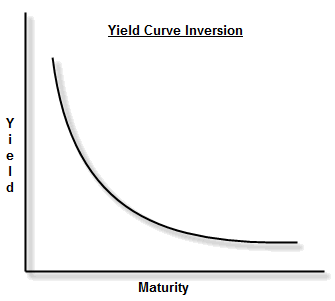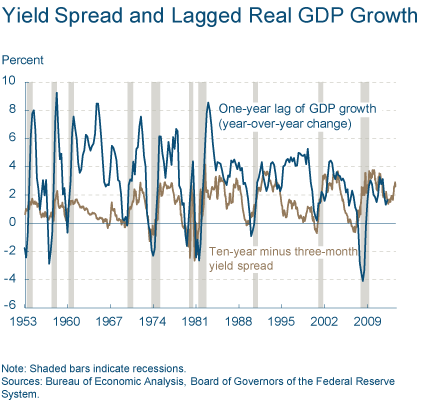With interest rates front and center these days, I thought we would take some time to explore the yield curve and some of the information that can be gleaned from it. The yield curve represents the relationship between interest rates on bonds of different maturities, but equal credit quality. For our purposes, we'll be discussing the U.S. Treasury yield curve.
The slope of the yield curve has proven to be a good forecaster of economic growth. There are three basic shapes the yield curve can take, each with different implications regarding economic growth. We'll explore these below and then take a look at the what the current yield curve is saying.
A normal, upward sloping yield curve is shown below. This is how the yield curve looks when an economy is growing and investors are confident. In a growing economy, investors demand an additional premium (yield) for longer maturity bonds. This is logical considering there is more risk associated with having money tied up for longer periods of time. Healthy economies nearly always have an upward sloping yield curve, although the interest rates that make up that curve may differ substantially from one period to another.
A flat yield curve indicates that investors are not being compensated for the additional risk of longer maturity bonds. This is a warning sign that an economy is under duress; investors expect slow growth, and economic indicators are sending mixed signals.
Like what you are reading? Subscribe to our daily podcast by clicking here
As investors buy and sell bonds to flatten the yield curve, they are demonstrating through their behavior that they are worried about the outlook of the economy. As a result, they prefer to have their money tied up longer in safe investments, and demand less of a return for doing so.
A flat yield curve can develop into the dreaded "inverted" yield curve when the economic outlook is very bleak. When the yield curve inverts, it indicates tough economic times ahead. The logic goes like this: If I'm worried the economy is going to crash, I want to look for safe ways of preserving my capital. If I suspect falling equity prices, and falling interest rates, I'm going to try to lock my capital away in longer-term bonds as a way to ride out the storm. As more and more investors do this, it drives longer maturity bond prices up, and the yields down. These same investors will shy away from short-term bonds, which may have to be reinvested during the downturn. This lack of demand drives short-term treasury prices down and the yields up.
There are multiple ways to analyze the slope of the yield curve, so which is the most accurate? Statistically, the method that has shown the most reliability in predicting future economic growth has been to look at the difference between the rates on the 10-year Treasury Note and the 3-Month Treasury Bill. When the yield on the 10-year is greater than the yield on the 3-Month, the slope is positive, and when this relationship reverses (3-Month rate greater than the 10-Year rate), the slope is negative and the yield curve is considered inverted.
Historical observations using this method show that an inverted yield curve indicates a recession approximately one year away. Inverted yield curves have preceded each one of the last seven recessions, as can be seen on the chart below.
This chart contains a wealth of information, so let's study it carefully. On the chart, the brown line represents the measure of slope we just discussed (the difference between yields on the 10-Year Treasury Note and the 3-Month Treasury Bill), going back to 1953. Each time this brown line drops below zero, the yield curve is considered to be inverted. Notice that this occurs immediately preceding the last seven gray vertical bars — which indicate recessions as defined by the Bureau of Economic Analysis.
The blue line shows GDP growth, and for the purposes of this chart, the GDP figures have been shown with a lag of one year. Looking at the chart with this lag allows us to see how closely correlated an inverted yield curve is with a drop in GDP one year out.
The last time the yield curve inverted was in August 2006; it provided advance warning for the recession that "officially" began in December 2007. Before that, the yield curve inverted in April 2000, predicting the 2001 recession. The only time this indicator gave a false signal was in 1966.
I'm guessing some of you are wondering whether this relationship will still hold in light of the massive amounts of quantitative easing. If I had to venture a guess I would say yes, and here's why. First, the FED can generally control short-term rates, but has much less effect on long-term rates, which are typically set by the market. Second, even the FED's control of short-term rates is not perfect, as evidenced by previous spikes in short-term Treasuries.
So what is the yield curve saying now? A sustained strong demand for Treasuries, combined with the recent rush to safety, has pushed the yield on the 10-year down below 2%. We have to look back almost two years, to when the Fed was heavily engaged in QE, to find a sustained period of rates this low. If the Fed does want to reduce the size of its large balance sheet by selling longer-dated bonds, this would be an opportune time as a global rush for safety and yield is suppressing rates in a way the Fed could only have dreamed of.
With short rates held at zero, continued declines in the yield on longer-dated maturities are acting to flatten the yield curve. In the chart below, the red line shows the current state of the yield curve. The black "trail" shows where the yield curve has been recently. As you can see, the yield curve is flattening, and this has precarious economic implications.
Related: Milan Zeleny: We Are Undergoing a Major Transformation, Not Just a Crisis
At this moment we should be attentive but not overly concerned. What will be interesting to see is how the yield curve responds to changes in Fed policy. I will go into much more detail on this topic in upcoming remarks, but prior to the financial crisis it was actually the Fed raising short rates, without the long end rising in tandem, that triggered the inverted yield curve which preceded the last recession. The curious side of me is constantly wondering if, when the Fed finally decides to tighten, it would be a better idea to sell longer-dated maturities (which would theoretically raise the long end of the curve), rather than raise the short end of the curve and "hope" it translates out. If I were Fed Chairman for a day, there is a good chance that would be my course of action.
Perhaps we shouldn't be surprised that investor behavior is acting to flatten the yield curve. After all, the Eurozone economy is stagnant, Japan is in recession, China's economy is slowing, and oil exporting countries and their currencies are under pressure. If it weren't for a robust U.S. economy, including solid gains in employment and corporate profits, I would be deeply concerned. What we need to watch closely here is to what extent global conditions act as an anchor for the U.S. economy, or whether worldwide conditions finally begin to improve as a result of continued central bank stimulus and renewed global growth.
The following was an excerpt of Richard Russell's Dow Theory Letters. To receive their daily updates and research, click here to subscribe.












